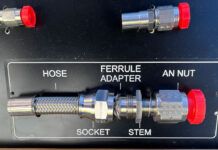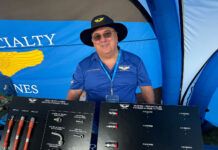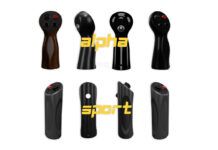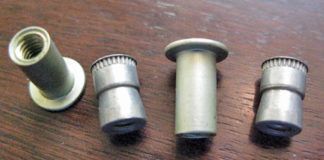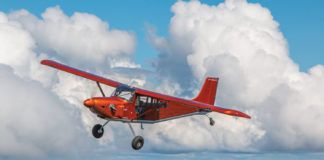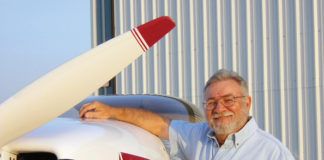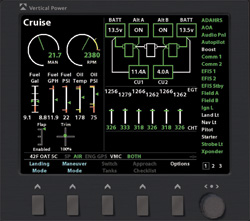
Virtually all modern engine monitors provide a plethora of information to the pilot. All basic functions are expected to be included with the offerings for our airplanes-you could say were information spoiled. Im happy to say that most builders with a sizable investment ahead of the firewall are seeing the value of all-inclusive monitoring. Its not just for the retentive types anymore.
At a minimum, you’ll be monitoring these temperatures: exhaust (EGT), head (CHT), turbine-inlet (TIT) outside-air (OAT) and oil (OT). Youll also be watching these pressures: manifold (MP), oil (OP) and fuel (FP). And you’ll have displays for fuel level, volts, amps, engine speed (rpm). The list grows to include checklists, weight-and-balance calculations as well as external inputs for various inputs such as a CO detector, landing gear and flap position, trim indication, data logging and more. Its possible with todays best engine monitors to watch and annunciate just about everything in the airframe, ridding your panel of extraneous displays, meters and dials (if thats what you have in mind). For the old-schoolers in the crowd who prefer discrete gauges for fear of putting all of their eggs in the same basket-and ending up with an omelette-in my shops experience, the modern engine monitors are dully reliable.
Public Displays of Attraction
Most systems present the information graphically on color LED or LCD type screens, though a good many monochrome (single color) displays that are completely useful remain. (The market has voted overwhelmingly for the living color versions.) Size varies from small to large. User interfaces are similar, and most allow the user to configure some or all of the parameters in the system such as limits, trends, minimum and maximum limits, colors and more. These functions vary by manufacturer and model, but all we’ve used and been exposed to are designed to be pilot- and user-friendly. I generally prefer instruments that can be fine-tuned by the builder, so things like operating limits and color arcs can be determined by the pilot through simple programming. Units that require a trip back to the factory to reset limits are a lot less useful, I think.
Were seeing the maturation of the products as they gradually add features and improve reliability-all of the popular choices today were around last year. (And some, like Sensornetics, which we featured last year, just haven’t shown up in the marketplace yet.)
The current market leaders are Advanced Flight Systems (AFS), Dynon Avionics and Grand Rapids Technologies (GRT). These three companies still account for the majority of Experimental engine monitors being sold and installed throughout the world. The reason for these three companies getting out front and staying there is easy to understand: They all make EFIS displays, and in this part of the market, consumers are choosing like brands because of the interoperability. (Kind of like the heady days of the 1970s, when it was desirable to have an all-King stack.)
Grand Rapids Technologies
The leader in terms of units sold for the Experimental market is Grand Rapids. The company’s venerable EIS (Engine Information System) probably has more systems flying than any other. While the EIS box by itself isn’t as flashy as the competitors, it is affordable and easy to install thanks to the company’s pre-made and provided wiring harnesses. Grand Rapids now has an optional LCD screen that couples with the EIS box to display the engine information graphically on a dedicated screen or interface to its popular EFIS.
The EIS box may also be purchased with an air data computer built into it that feeds other EFISes such as Chelton, or to provide a rudimentary VFR flight instrument for many ultralights. A complete engine-monitoring system including probes and sensors starts at less than $1000. Optional probes and sensors can increase the cost, but its still one of the most affordable systems available today. Grand Rapids is one of the few companies that supports automotive and alternative engine conversions, as well as radial and turbine installations. It also supports integration and interfaces with the Vertical Power system and Chelton EFISes. Its worth noting that the GRT engine monitor display has undergone a major overhaul in its screen resolution and display layout.
Dynon Avionics
Dynon had one of the first small and affordable graphical engine monitors with the introduction of its 3.125-inch EMS-D10. Sized to fit into a standard instrument cutout, it has been a very successful product. Expanding on the 10, Dynon also offers a larger screen D120 as a standalone engine monitor or to combine with its EFIS in the FlightDEK-D180. These units, like their competitors, are easy to use, pack in a ton of information and are also user-friendly to install with the provided installation harnesses. Dynon has expanded its support team and has a dedicated online support forum for its users, which has proven to be popular.
Dynon has also made inroads with many of the Light Sport Aircraft manufacturers, and its systems have become some of the most popular OEM-installed graphical engine monitors in LSAs. Like most of its competitors, Dynon offers complete probe and sensor packages for a multitude of engines options, but at the moment the company does not support turbine or radial engine configurations. The basic EMS-D10/D120 currently supports both four- and six-cylinder engines-including Rotax and Jabiru-with all-cylinder EGT and CHT, plus the usual other measurements. You can hook up your trim and flap-position sensors and have them read out on the EMS as well as a linked Dynon EFIS. Last year, the company released a new piece of software that included a percent-of-power meter that takes into account whether you’re running rich or lean-of-peak EGT. Data logging is standard, too.
Advanced Flight Systems
Early in the new millennium, RV builder and electronics guru Rob Hickman desired a fully functional and affordable graphical engine monitor. When he found there were no options that met his requirements, Hickman simply made his own. Advanced Flight Systems was born, and was one of the first to offer a color graphical engine monitor. As demand grew, so did the product line, and now the AFS engine monitors are some of the most popular systems around.
These monitors have several features that are not in competitors units such as a backup battery, Ethernet cable connection to its other products, as well as data recording/logging direct to a front loading SD card, and AFS is one of few companies to provide a complete no hidden charges package of probes and sensors without making some of them available at additional cost. (Most other companies make some probes/sensors such as a fuel flow sensor optional at additional cost). It should also be noted that AFS systems will integrate with other EFISes and products from companies such as Vertical Power and Chelton. AFS also offers online support.
Electronics International
Electronics International has created a niche as one of the highest quality premium engine monitors available. Its history with a respected line of digital engine instruments led to the creation of its flagship product, the MVP-50. With a mid-sized LCD screen, EIs MVP-50 is frequently found in high-end and high-performance aircraft. It is one of the few companies that has experience supporting complex turbine and jet installations as well as radial engines and other alternative engine configurations. It is also one of the only companies I know of that designs and manufactures its own probes and sensors, and they’re even used by other engine monitor manufacturers. EI has many optional configurations and supports outputs for some other EFISes by offering an air-data module. Its products are FAA certified, and the company has an excellent reputation for outstanding customer support and strong support of Experimental aviation.
Advanced Flight, Dynon, EI and GRT compose the majority of units installed by homebuilders, but they are by no means the only options available. Other companies have offerings for aircraft from ultralights to Bonanzas.
J.P. Instruments
J.P. Instruments is arguably the biggest player in the certified market, and its 3.125-inch round engine monitors are ubiquitous in the store-bought fleet. The company’s products are widely seen in, for lack of a better term, pre-EFIS homebuilts-that is, the aircraft built, say, five to 15 years ago. In addition to its line of round instruments, JPI has the EDM-900 and EDM-930, which are all-inclusive systems. The 900 is a gas-discharge single-color (with color overlays) display, while the 930 is a full-color LCD.
In the last three years, JPI purchased Vision Microsystems and its line of engine monitors. The news now is that Visions founder, Lance Turk, has left the soggy Northwest to work at JPI headquarters in Southern California. Vision Micro was one of the first companies to offer a graphical engine monitor, and they were quite popular for some time. However, with the introduction of modern graphical engine monitors, the popularity of the VM systems languished. Nevertheless, there are many VM installations out there, and they remain viable. Under JPI, the VM systems have been adapted to use JPI probes. With Turk back in the fold, we can expect some exciting new products in this lineup.
MGL Avionics
MGL Avionics is a relative newcomer to the mainstream homebuilding community, but it has been quite popular in ultralight aircraft for years and has delivered many units worldwide. Based in South Africa, the company is run by Ranier Lamers, whose small business offers some of the most affordable units available. The Stratomaster is popular and is offered in various configurations for many types of aircraft. MGL also offers a suite of 2.25- and 3.125-inch instruments that cover a wide range of functions such as pressure instruments, electrical measurement, CHT/EGT, temperatures and more.
In fact, the smaller Infinity singles have been redesigned this year. Instead of the angular front panel, the instruments have a round bezel so they fit handsomely in a 2.25-inch hole. As before, MGLs singles line includes a partial engine monitor in the E-3, though it doesn’t display all of the engine parameters at once, and can watch only a limited number of EGTs and CHTs. The E-3 has essentially four inputs plus rpm. If you choose to watch a pressure and temperature, then two are left for your choice of EGT or CHT or one each. The Infinity line also includes a fuel computer, dedicated temp/pressure gauges and others. You could build a modular engine monitor from the components, but for many with simple engines-the Rotax 912 in particular-the E-3 probably fits the bill just fine.
And the Rest…
I-K Technologies is another small business that, like MGL Avionics, offers a number of systems at affordable prices. Several options are available with a unique display that mixes an LCD readout along with a number of LED bars in red, yellow and green. With the I-K Technologies engine monitors its easy to quickly glance at your display and notice the status of all of your parameters. The I-K systems are somewhat customizable, and they provide a number of possible configurations.
Xerion has received FAA certification for its Auracle graphical engine monitor, and though not focused on the homebuilt market, it has some systems installed in Experimental aircraft. With the focus on certified aircraft, its costs are a bit higher than its competitors. The Auracle is a graphical engine monitor that offers most of the expected functionality.
Why We’re Here
The market has none-too-subtly shifted to a one manufacturer philosophy at the mid-level and up, and thats so the engine monitor and EFIS can communicate, share data and provide information across multiple displays. If you intend to install an EFIS in your airplane, then its a natural fit to install an engine monitor from the same company. Many of them are even available integrated into an EFIS, so in the end you have a complete and integrated system. Some mixing and matching can take place, but its generally wise to stick with the same manufacturer. It’s getting increasingly difficult to differentiate systems because most are offering expanded functionality, great displays and affordability. All of them are almost universally far more accurate than their outdated steam-gauge counterparts and will offer greater reliability over the long term. Ultimately, as I said last year, I can offer three main rules for purchasing an engine monitor.
- Purchase the same brand engine monitor as your EFIS if you’re going to use an EFIS.
- Don’t buy more than you need. If you’re building an ultralight, you simply don’t need 80 different data points for your engine (like fuel flow, fuel pressure, OAT, etc.).
- Don’t buy an engine monitor and then install backup engine instruments. If your engine monitor were to fail, the fan on the front does not immediately stop. You generally cannot share sensors, so that means extra sensors, extra wiring, extra complexity and little extra functionality or usability. Trust me, it’s not worth the effort.
Overall I encourage everyone to get an engine monitor. If you haven’t used one before, you’ll be pleasantly surprised. Stay tuned for more changes in what becomes available!

